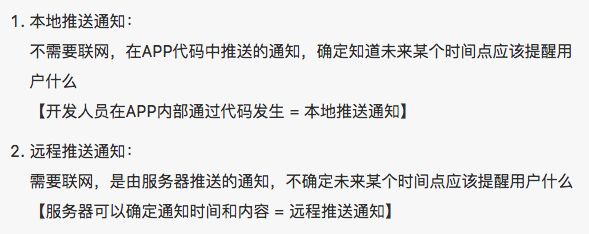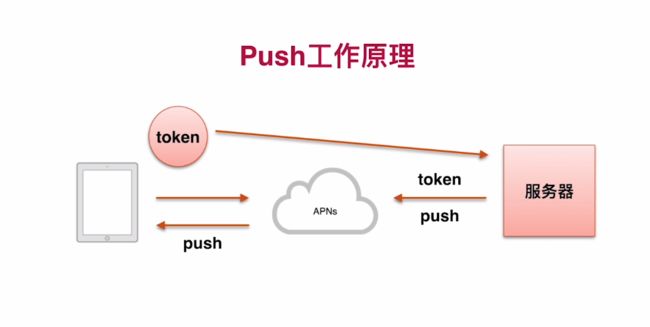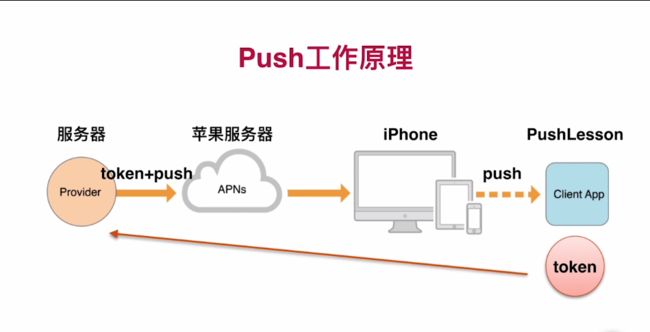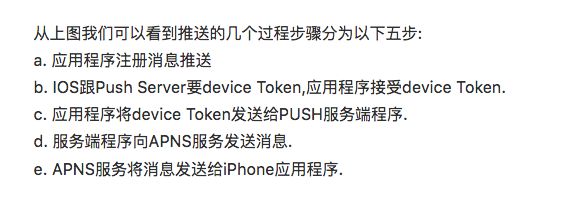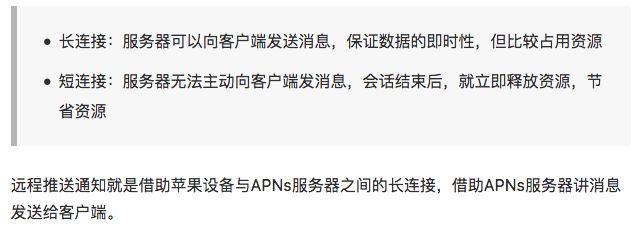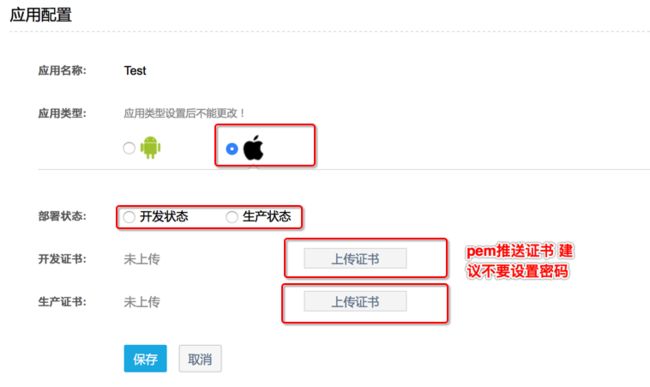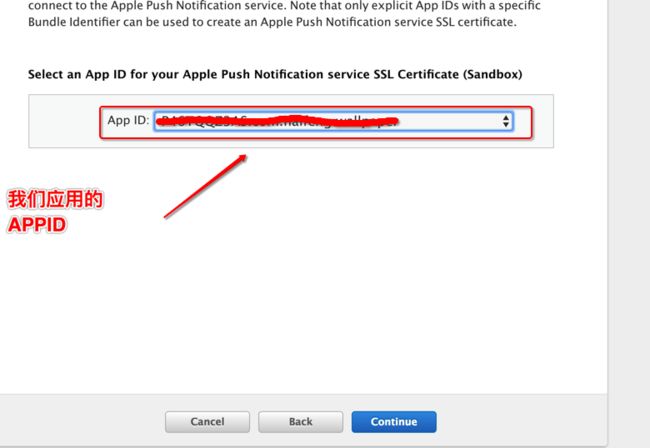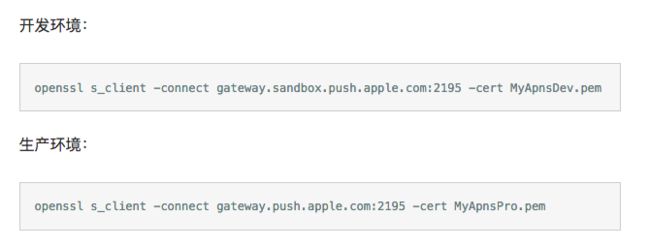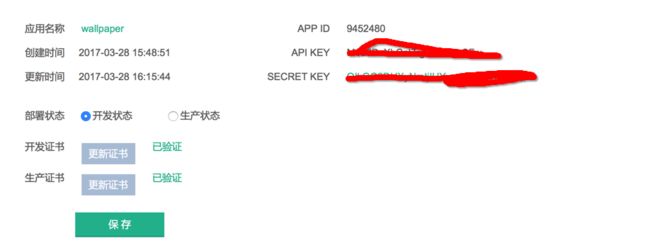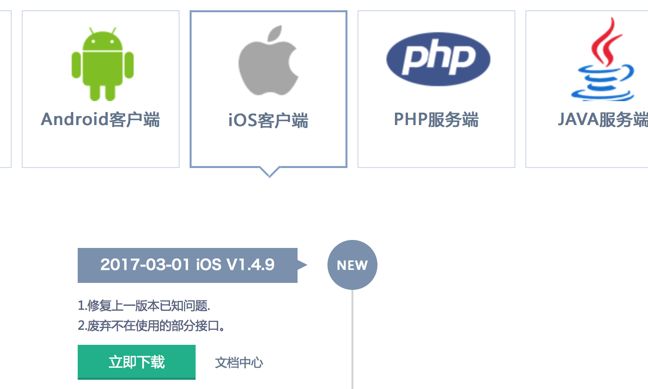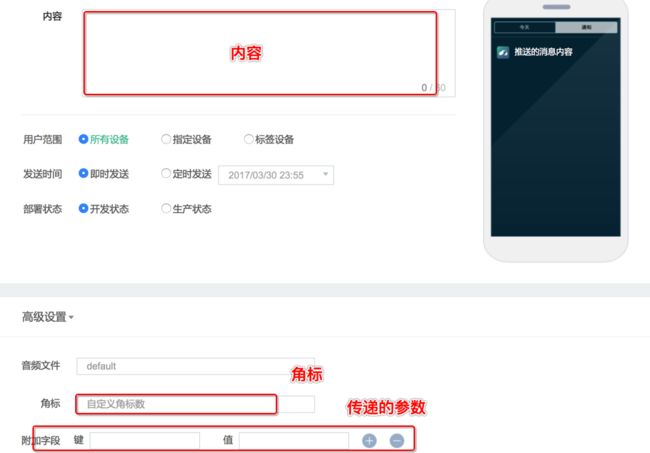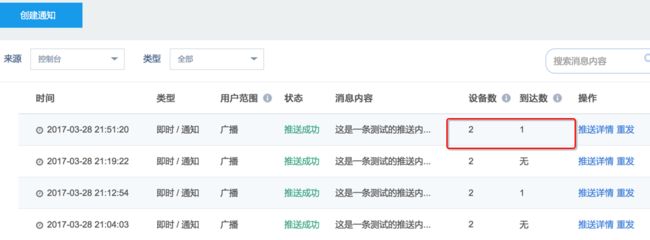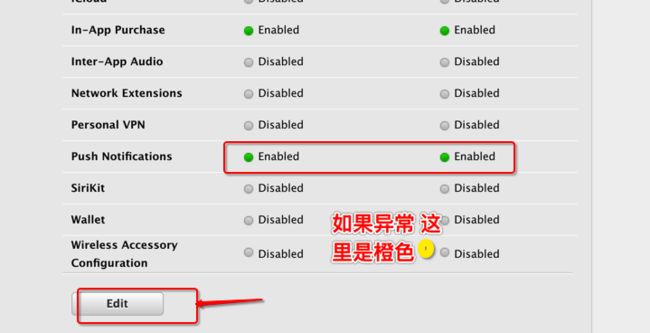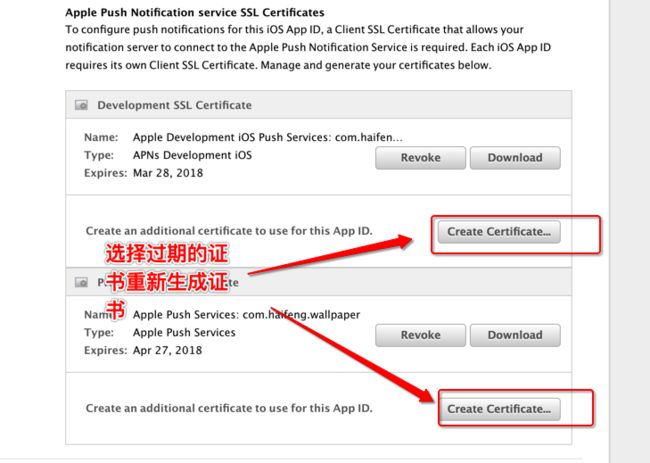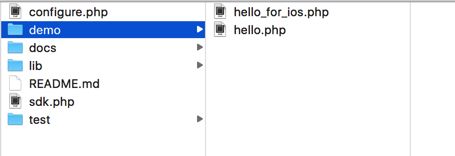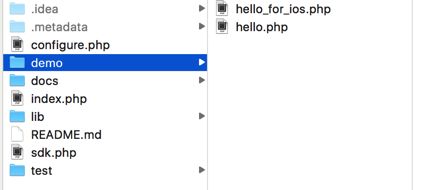1.概念及相关知识点
推送通知就是向用户推送一条信息来通知用户某件事件,可以在应用退到后台后,或者关闭后,能够通过推送一条消息通知用户某件事情,比如版本更新等等。
推送通知的常用应用场景:
推送通知的常用展示样式:
推送通知分类:
使用原则:谁确定通知时间和内容,谁就可以发生
2.本地推送通知
1.本地推送通知步骤:
1.在iOS8以后使用本地推送通知,需要得到用户的许可
2.创建UILocalNotification本地通知对象,并设置必要属性
3.开始本地推送通知:
第一种方法:延时推送,根据本地通知对象的fireDate设置进行本地推送通知
[[UIApplication shareApplication] scheduleLocalNotification:notification];
第二种方法:立刻推送,忽略本地通知对象的fireDate设置进行本地推送通知
[[UIApplication shareApplication] presentLocalNotificationNow:notification];
4.监听用户点击通知:
- APP处于前台,此时不会弹框通知用户,但会调用对应的代理方法 :
-(void)application:(UIApplication *)application didReceiveLocalNotification;
- APP处于后台,屏幕上方会弹出横幅,用户点击横幅后,会进入前台,调用上面的代理方法
- APP已关闭,屏幕上方会弹出横幅,用户点击横幅后,会启动APP,调用以下方法:
-(BOOL)application:(UIApplication *)application
didFinishLaunchingWithOptions:(NSDictionary *)launchOptions;
/* 通过参数launchOptions获取本地推送通知内容 */
UILocalNotification *local = launchOptions[UIApplicationLaunchOptionsLocalNotificationKey];
5.调用UIApplication的对象方法,取消本地推送通知:
/* 取消指定的本地推送通知 */
-(void)cancelLocalNotification:(UILocalNotification *)notification;
/* 取消全部本地推送通知 */
-(void)cancelAllLocalNotification;
2.Demo:
- 注册通知代码以及UIAlertView显示通知方法代码
- (BOOL)application:(UIApplication *)application
didFinishLaunchingWithOptions:(NSDictionary *)launchOptions
{
//因为是storyboard启动,这里就没有其他启动代码了
//iOS8.0以后,如果需要使用推送通知,需要得到用户许可
if (application.currentUserNotificationSettings.types == UIUserNotificationTypeNone) {
//注册通知,有横幅通知、应用数字通知、应用声音通知
UIUserNotificationSettings * setting =
[UIUserNotificationSettings settingsForTypes:UIUserNotificationTypeAlert |
UIUserNotificationTypeBadge |
UIUserNotificationTypeSound
categories:nil];
[application registerUserNotificationSettings:setting];
} else {
//当APP关闭后接收到通知,在启动中获取本地推送通知对象
UILocalNotification *notification = launchOptions[UIApplicationLaunchOptionsLocalNotificationKey];
[self showLocalNotification:notification];
}
return YES;
}
/* 弹框UIAlertView显示本地通知的信息 */
- (void)showLocalNotification:(UILocalNotification *)notification
{
/* 显示本地通知 */
NSDictionary *userInfo = notification.userInfo;
NSString *title = @"本地通知";
NSString *msg = userInfo[@"msg"];
UIAlertView *alert = [[UIAlertView alloc] initWithTitle:title
message:msg
delegate:nil
cancelButtonTitle:@"取消"
otherButtonTitles:@"确定", nil];
[alert show];
//移除本地通知
[[UIApplication sharedApplication] cancelLocalNotification:notification];
}
2.创建本地通知代码
/* 创建一个本地通知 */
- (UILocalNotification *)makeLocalNotification{
//创建本地推送通知对象
UILocalNotification *notification = [[UILocalNotification alloc] init];
//设置调用时间
notification.fireDate = [NSDate dateWithTimeIntervalSinceNow:10.0];//通知触发的时间,10s以后
notification.repeatInterval = NSCalendarUnitMinute;//每隔多久重复发一次本地通知
//设置通知属性
notification.alertBody = @"最近添加了诸多有趣的特性,是否立即体验?";//通知主体
notification.applicationIconBadgeNumber = 1;//应用程序图标右上角显示的消息数
notification.alertAction = @"打开应用"; //待机界面的滑动动作提示
notification.alertLaunchImage = @"Default";//通过点击通知打开应用时的启动图片,这里使用程序启动图片
notification.soundName = UILocalNotificationDefaultSoundName;//收到通知时播放的声音,默认消息声音
//设置用户信息
notification.userInfo = @{ @"id":@1,
@"user":@"Kenshin Cui",
@"msg":@"我来了一发本地通知"};//绑定到通知上的其他附加信息
return notification;
}
如果需要每天的中午12点准时本地推送怎么办呢?
就像这么办,修改fireDate和repeatInterval属性
NSDateFormatter *formatter1 = [[NSDateFormatter alloc]init];
[formatter setDateFormat:@"yyyy-MM-dd HH-mm-sss"];
NSDate *resDate = [formatter dateFromString:@"2016-04-09 12-00-00"];
notification.fireDate = resDate;//设定为明天中午12点触发通知
//记得设置当前时区,没有设置的话,fireDate将不考虑时区,这样的通知会不准确
notification.timeZone = [NSTimeZone defaultTimeZone];
notification.repeatInterval = NSCalendarUnitDay;//每隔一天触发一次
3.监听用户点击
/* 注册本地通知完成会调用,即用户点击确定授权后调用 */
- (void)application:(UIApplication *)application
didRegisterUserNotificationSettings:(UIUserNotificationSettings *)notificationSettings
{
//在这里我们尝试发送本地推送通知
if (notificationSettings.types != UIUserNotificationTypeNone) {
UILocalNotification *notification = [self makeLocalNotification];
//延迟调用通知
[application scheduleLocalNotification:notification];
//立刻发送通知
//[application presentLocalNotificationNow:notification];
}
}
/* 应用还在运行,无论前台还是后台,都会调用该方法处理通知 */
- (void)application:(UIApplication *)application
didReceiveLocalNotification:(UILocalNotification *)notification
{
if( notification ) {
[self showLocalNotification:notification];
}
}
/* 应用进入前台,去除应用边角数字显示 */
- (void)applicationWillEnterForeground:(UIApplication *)application {
//去除应用边角数字
[application setApplicationIconBadgeNumber:0];
}
效果如图:
3.远程推送通知
原理图:
1.相关知识点
下面是更详细的流程:
所有的苹果设备,在联网状态下,都会和苹果服务器APNs建立一个长连接
2.远程推送通知实现的条件
1.必须有真机,只有真机具备UDID,才能生成deviceToken设备令牌
2.需要开发推送Cer证书
证书的申请请参考:iOS学习笔记21-推送证书与秘钥申请
** deviceToken的生成算法只有Apple掌握,为了确保算法发生变化后仍然能够正常接收服务器端发送的通知,每次应用程序启动都重新获得deviceToken**
3.远程推送通知步骤
1.iOS8以后,使用远程通知,需要请求用户授权
2.注册远程通知成功后会调用以下方法,获取deviceToken设备令牌:
-(void)application:(UIApplication *)application
didRegisterForRemoteNotificationsWithDeviceToken:(NSData *)deviceToken;
3.把deviceToken设备令牌发送给服务器,时刻保持deviceToken是最新的
4.监听远程推送通知:
-(void)application:(UIApplication *)application
didReceiveRemoteNotification:(NSDictionary *)userInfo;
4.Demo:
1. 注册远程推送通知代码:
- (BOOL)application:(UIApplication *)application
didFinishLaunchingWithOptions:(NSDictionary *)launchOptions
{
//iOS8.0以后,如果需要使用本地推送通知,需要得到用户许可
if (![application isRegisteredForRemoteNotifications]) {
UIUserNotificationSettings * setting =
[UIUserNotificationSettings settingsForTypes:UIUserNotificationTypeAlert |
UIUserNotificationTypeBadge |
UIUserNotificationTypeSound
categories:nil];
[application registerUserNotificationSettings:setting];
//注册远程推送通知
[application registerForRemoteNotifications];
}
return YES;
}
2. 注册成功调用代码:
/* 注册远程推送通知成功会调用 ,在此接收设备令牌deviceToken */
- (void)application:(UIApplication *)application
didRegisterForRemoteNotificationsWithDeviceToken:(NSData *)deviceToken
{
[self addDeviceToken:deviceToken];
}
/* 保存deviceToken,并同步服务器上保存的deviceToken,以便能正确推送通知 */
- (void)addDeviceToken:(NSData *)deviceToken
{
NSString *key = @"DeviceToken";
NSUserDefaults *defaults = [NSUserDefaults standardUserDefaults];
//取出原来的deviceToken,进行比较
NSData *oldToken = [defaults objectForKey:key];
if ([oldToken isEqualToData:deviceToken]) {
//存入新的deviceToken
[defaults setObject:deviceToken forKey:key];
[defaults synchronize];
//发送网络请求到服务器,说明deviceToken发生了改变
[self sendDeviceTokenWithOldDeviceToken:oldToken newDeviceToken:deviceToken];
}
}
/* 发送网络请求到服务器,说明deviceToken发生了改变,服务器那边也要同步改变 */
- (void)sendDeviceTokenWithOldDeviceToken:(NSData *)oldToken newDeviceToken:(NSData *)newToken
{
//发送到服务器,下面是服务器的一个接口
NSString *urlStr = @"http://192.168.1.101/RegisterDeviceToken.aspx";
urlStr = [urlStr stringByAddingPercentEscapesUsingEncoding:NSUTF8StringEncoding];
NSURL *url = [NSURL URLWithString:urlStr];
//POST网络请求
NSMutableURLRequest *requestM = [NSMutableURLRequest requestWithURL:url];
requestM.HTTPMethod = @"POST";
//POST请求的请求体
NSString *bodyStr = [NSString stringWithFormat:@"oldToken=%@&newToken=%@",oldToken,newToken];
requestM.HTTPBody = [bodyStr dataUsingEncoding:NSUTF8StringEncoding];
//使用会话来发送网络请求
NSURLSession *session = [NSURLSession sharedSession];
NSURLSessionDataTask *dataTask =
[session dataTaskWithRequest:requestM
completionHandler:^(NSData *data,NSURLResponse *response,NSError *error){
if(!error){
NSLog(@"Send Success !");
} else {
NSLog(@"Send Failure, error = %@",error.localizedDescription);
}
}];
//网络请求任务启动
[dataTask resume];
}
3.监听远程推送通知:
/* 收到远程推送通知时会调用 */
- (void)application:(UIApplication *)application
didReceiveRemoteNotification:(NSDictionary *)userInfo
{
NSString *title = @"远程推送通知";
NSString *msg = userInfo[@"msg"];
UIAlertView *alert = [[UIAlertView alloc] initWithTitle:title
message:msg
delegate:nil
cancelButtonTitle:@"取消"
otherButtonTitles:@"确定", nil];
[alert show];
}
iOS推送总结:http://www.jianshu.com/p/34a408b2f53a#
4.第三方远程推送简介
上面的远程推送过程如果觉得实现比较麻烦,你可以使用第三方推送(具体的集成步骤及使用方法,请查看对应的官方文档,非常详细),例如:
- 极光推送( JPush ):https://www.jiguang.cn/push#B_vid=8707896807058745439
ios 极光推送的集成及注意事项(含收到通知后点击弹框跳转):https://www.jianshu.com/p/1d37efd7d65c - 百度云推送:http://push.baidu.com/
- 腾讯信鸽:https://www.qcloud.com/product/XGPush?fromSource=gwzcw.12791.12791.12791
- 个推:http://www.getui.com/cn/index.html
- 友盟推送:http://push.umeng.com/pushIndex?utm_source=bdsem&utm_medium=search&utm_campaign=push
- 教你一步一步获取App ID:http://www.jianshu.com/p/074bc6fffd0e
- 教你一步一步获取Provisioning Profiles:http://www.jianshu.com/p/6aa72b177daf
5.详解百度推送的具体使用
大致步骤
百度云iOS文档:http://push.baidu.com/doc/ios/api
1.创建应用拿到AppKey(需要先拿到证书)
2.生成推送所需要的证书
3.创建iOS工程,集成百度SDK
1.1注册百度账号
http://push.baidu.com/
2.创建应用获取AppKey
设置应用名称
应用配置完成 得到API KEY
3.生成推送所需要的pem证书
3.1 在开发者中找到我们的应用对应的APPID
3.2 选择证书关联的APPID
3.3 选择电脑钥匙串办法的证书
3.4 同样的操作就会生成两个cer证书,双击安装到我们的钥匙串中
3.5导出两个P12文件
3.6将导出的P12通过命令导出百度需要的pem证书
3.7 证书与证书校验
与 APNs 之间是加密的连接,因此需要使用证书来加密连接。每个的推送环境有自己单独的推送证书,即开发证书和生产证书。再将证书最终转为 pem 格式后,可通过与 APNs 连接来测试证书是否有效。
3.8通知的两种推送环境
在使用 iOS 远程推送功能时,有两种不同的环境。开发环境(Development)以及生产环境(Production);
App 当前使用的推送环境与 Xcode - Build Settings - Code Signing - Provisioning Profile 文件的模式一致
3.9 将pem证书上传到我们百度创建的应用中
这样我们前期的配置工作就完成了。由于苹果APNS是加密过的,所以我们需要将证书传递给百度,接下来我们在我们项目中将DeviceToken传递给百度,它会绑定生成一个对应的channel_ID.
channel_id : channel_id是用于表示一台设备的唯一标识, 在推送消息时,用于指定消息的目标接收设备.
4. 工程中集成百度SDK
4.1 下载百度SDK地址
下载后的文件目录
4.2 将红色的部分拖进项目中去,test.caf不需要
4.3 对于Xcode8.0配置
4.4 在AppDelegate.m中初始化百度推送(先导入BPush.h)
大致的模板如下AB部分代码(具体一些细节的代码、回调等具体情况自己分析添加...)
A. 系统方法中配置推送消息
- (BOOL)application:(UIApplication *)application
didFinishLaunchingWithOptions:(NSDictionary *)launchOptions {
......
// 百度推送
// iOS8 下需要使用新的 API
if ([[[UIDevice currentDevice] systemVersion] floatValue] >= 8.0) {
UIUserNotificationType myTypes = UIUserNotificationTypeBadge |
UIUserNotificationTypeSound | UIUserNotificationTypeAlert;
UIUserNotificationSettings *settings = [UIUserNotificationSettings
settingsForTypes:myTypes categories:nil];
[[UIApplication sharedApplication] registerUserNotificationSettings:settings];
}
BOOL isDebug;
BPushMode model;
#ifdef DEBUG
isDebug = YES;
model = BPushModeDevelopment;// 推送模式设置
// 在debug环境下开启日志手机
[BugManager redirectNSLogToDocumentFolder];
#else
isDebug = NO;
model = BPushModeProduction;
#endif
// 在App启动时注册百度云推送服务,需要提供 Apikey
[BPush registerChannel:launchOptions apiKey:BDApikey pushMode:model
withFirstAction:nil withSecondAction:nil withCategory:nil isDebug:isDebug];
NSDictionary *userInfo = [launchOptions objectForKey:
UIApplicationLaunchOptionsRemoteNotificationKey];
if (userInfo) {
[BPush handleNotification:userInfo];
[self didAcceptPushNotification:userInfo isAction:YES];//这个
是自己写的方法:里面有接受通知后显示的内容、弹框、跳转....
}
//角标清0
[[UIApplication sharedApplication] setApplicationIconBadgeNumber:0];
SXLog(@"%@",NSLocalizedStringEx(@"NAME", nil));
......
return YES;
}
B. 添加以下方法
#pragma mark -- 推送相关回调
1.// 在iOS8系统中,还需要添加这个方法。通过新的ApI 注册推送服务
- (void)application:(UIApplication *)application
didRegisterUserNotificationSettings:(UIUserNotificationSettings *)notificationSettings
{
[application registerForRemoteNotifications];
}
2.// 当注册成功时候返回 deviceToken(用于获取 APNs 返回给设备的 DeviceToken)
- (void)application:(UIApplication *)application
didRegisterForRemoteNotificationsWithDeviceToken:(NSData *)deviceToken {
......
}
3.// 当 DeviceToken 获取失败时,系统会调用此回调方法(用于当获取不到 DeviceToken 时,查看其错误原因)
- (void)application:(UIApplication *)application
didFailToRegisterForRemoteNotificationsWithError:(NSError *)error
{
NSLog(@"DeviceToken 获取失败,原因:%@",error);
}
4.// 当用户点击了通知 应用在前台或者开启后台并且应用在后台 时调用
- (void)application:(UIApplication *)application
didReceiveRemoteNotification:(NSDictionary *)userInfo fetchCompletionHandler:(void (^)(UIBackgroundFetchResult))completionHandler
{
......
}
举例代码:
#import "AppDelegate.h"
#import
#import "BPush.h"
#import "ViewController.h"
@interface AppDelegate ()
@end
@implementation AppDelegate
- (BOOL)application:(UIApplication *)application didFinishLaunchingWithOptions:(NSDictionary *)launchOptions {
// iOS10 下需要使用新的 API
if ([[[UIDevice currentDevice] systemVersion] floatValue] >= 10.0) {
#ifdef NSFoundationVersionNumber_iOS_9_x_Max
UNUserNotificationCenter* center = [UNUserNotificationCenter currentNotificationCenter];
[center requestAuthorizationWithOptions:(UNAuthorizationOptionAlert + UNAuthorizationOptionSound + UNAuthorizationOptionBadge)
completionHandler:^(BOOL granted, NSError * _Nullable error) {
// Enable or disable features based on authorization.
if (granted) {
[application registerForRemoteNotifications];
}
}];
#endif
}
else if ([[[UIDevice currentDevice] systemVersion] floatValue] >= 8.0) {
UIUserNotificationType myTypes = UIUserNotificationTypeBadge | UIUserNotificationTypeSound | UIUserNotificationTypeAlert;
UIUserNotificationSettings *settings = [UIUserNotificationSettings settingsForTypes:myTypes categories:nil];
[[UIApplication sharedApplication] registerUserNotificationSettings:settings];
}else {
UIRemoteNotificationType myTypes = UIRemoteNotificationTypeBadge|UIRemoteNotificationTypeAlert|UIRemoteNotificationTypeSound;
[[UIApplication sharedApplication] registerForRemoteNotificationTypes:myTypes];
}
#warning 测试 开发环境 时需要修改BPushMode为BPushModeDevelopment 需要修改Apikey为自己的Apikey
[BPush registerChannel:launchOptions apiKey:@"M4a6DvXbCnl7rgvLcVeIwSFw" pushMode:BPushModeDevelopment withFirstAction:@"打开" withSecondAction:@"关闭" withCategory:@"test" useBehaviorTextInput:YES isDebug:YES];
// App 使用户点击推送消息启动
NSDictionary *userInfo = [launchOptions objectForKey:UIApplicationLaunchOptionsRemoteNotificationKey];
if (userInfo) {
[BPush handleNotification:userInfo];
}
// 清除角标
[[UIApplication sharedApplication] setApplicationIconBadgeNumber:1.0];
return YES;
}
#pragma Gegistnotification
// 在iOS8中,还需要添加这个方法。通过新的ApI 注册推送服务
- (void)application:(UIApplication *)application didRegisterUserNotificationSettings:(UIUserNotificationSettings *)notificationSettings
{
[application registerForRemoteNotifications];
}
// 当 DeviceToken 获取失败时,系统会调用此回调方法
- (void)application:(UIApplication *)application didFailToRegisterForRemoteNotificationsWithError:(NSError *)error
{
NSLog(@"DeviceToken 获取失败, 原因是: %@", error);
}
// 当注册成功时候返回 deviceToken
- (void)application:(UIApplication *)application didRegisterForRemoteNotificationsWithDeviceToken:(NSData *)deviceToken
{
NSLog(@"%@-----", deviceToken);
[BPush registerDeviceToken:deviceToken];
// 绑定Push服务通道 error_code为0是绑定成功 绑定成功后可以获取appid,channelid,userid等信息
[BPush bindChannelWithCompleteHandler:^(id result, NSError *error) {
if (result) {
if ([result[@"error_code"] intValue] != 0) {
return ;
}
// 获取channel_id
NSString *myChange_id = [BPush getChannelId];
// [BPush getAppId];
// [BPush getUserId];
NSLog(@"%@", myChange_id);
[BPush setTag:@"MyTag" withCompleteHandler:^(id result, NSError *error) {
if (result) {
// BPushCallBack中有设置标签结果的反馈,,error_code 为0时设置成功会得到设置结果。
NSLog(@"result==================%@", result);
}
}];
}
}];
}
// 当用户点击了通知 应用在前台 或者开启后台并且应用在后台 是调用
- (void)application:(UIApplication *)application didReceiveRemoteNotification:(NSDictionary *)userInfo fetchCompletionHandler:(void (^)(UIBackgroundFetchResult))completionHandler
{
NSLog(@"%@", userInfo);
// 应用在前台 不跳转页面
if (application.applicationState == UIApplicationStateActive) {
UIAlertView *alert = [[UIAlertView alloc] initWithTitle:@"收到一条消息" message:userInfo[@"aps"][@"alert"] delegate:self cancelButtonTitle:@"取消" otherButtonTitles:@"确定", nil];
[alert show];
}
// 杀死情况下 直接跳转到页面
if (application.applicationState == UIApplicationStateInactive) {
/*
SkipViewController *skipCtr = [[SkipViewController alloc] init];
[_tabBarCtr.selectedViewController pushViewController:skipCtr animated: YES];
*/
}
// 应用在后台 当后台设置apps字段里的
if(application.applicationState == UIApplicationStateBackground){
ViewController *vc = (ViewController *)self.window.rootViewController;
vc.textView.text = userInfo.description;
}
}
4.5 在百度后台创建发送通知
4.6 查看推送列表
5.对于证书过期的处理
5.1 到苹果开发者中心,找到对应的AppID
5.2 选择过期的证书 重新生成对应的证书
5.3 按这上面的步骤上传到百度我们创建的应用中,就可以正常的发送通知了
拓展:用PHP集成百度推送
1.下载PHP对应SDK
下载后的SDK目录:
将项目拖拽到我们本地的服务器站点
2.配置项目
- 修改configure.php中的defaultapiKey及defaultsecurekey,填入在Setp 2中获得的apikey及secure key.
在hello_for_ios.php 中脚本中发送一个推送
推送消息的格式


